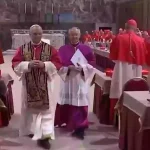When Robert Prevost was announced as the new leader of the Catholic Church on May 8, many were surprised to learn that he would not be called Pope Robert or Pope Prevost. Instead, he chose the name Pope Leo XIV.
This tradition of selecting a new name upon becoming pope has been followed by every pontiff for over 470 years. The practice dates back to the first pope, St. Peter, whose original name was Simon.
Choosing a new name is a symbolic act that signifies a fresh start and a renewed spiritual mission. The name a pope chooses often carries significant meaning and reflects the values he wishes to emphasize during his tenure.

Many popes select the name of a predecessor to honor their legacy or to signal their intention to continue a particular mission or message.
For example, Pope Francis chose his name to honor St. Francis of Assisi, known for his dedication to poverty, humility, and peace.
Pope Leo XIV is the first pontiff to take the name Leo since Pope Leo XIII, who served from 1878 to 1903. Pope Leo XIII is remembered for his influential encyclical “Rerum Novarum,”



